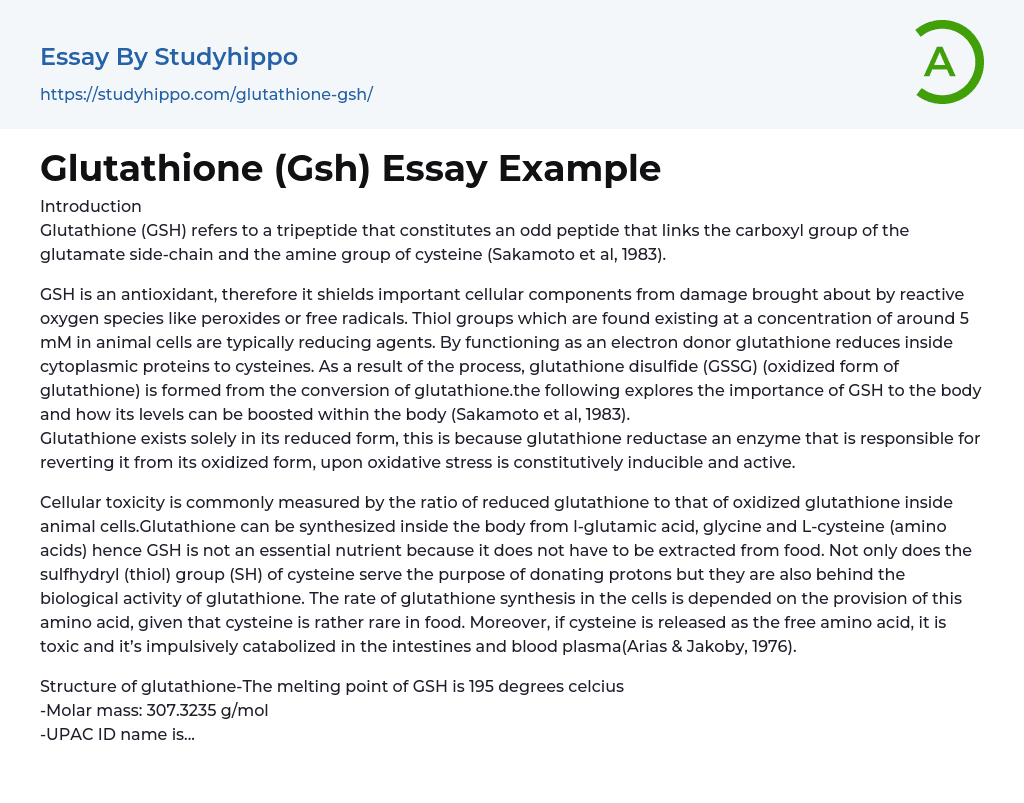As stated by Sakamoto et al in 1983, the tripeptide glutathione (GSH) has a unique peptide bond that connects the carboxyl group of the glutamate side-chain with the amine group of cysteine. This is introduced in this paragraph.
Glutathione, also known as GSH, serves as an antioxidant that safeguards vital cellular components from injury caused by reactive oxygen species like peroxides and free radicals. GSH comprises thiol groups in animal cells which function as reducing agents at a concentration of about 5 mM. This enables it to act as an electron donor and convert cytoplasmic proteins into cysteines that form glutathione disulfide (GSSG), the oxidized version of glutathione. In their 1983 study, Sakamoto et al explore the significance of GSH in the body and strategies to elevate its levels within the body. Oxidative stress triggers induction and activity of glutathione reductase, e
...nabling it to remain in its reduced state.
Toxicity in animal cells is generally determined by the ratio of oxidized glutathione to reduced glutathione. Glutathione, which can be synthesized within the body using amino acids like L-glutamic acid, glycine, and L-cysteine, plays a crucial role in biological activity thanks to the thiol group (SH) present in cysteine that acts as a proton donor. While not an essential nutrient derived from food, GSH synthesis is possible since it can be produced endogenously. However, cells' ability to generate glutathione depends on their access to cysteine, which isn't commonly found in food sources. Although free amino acid cysteine may pose a risk when released into the bloodstream or intestines, it's rapidly metabolized (Arias ; Jakoby, 1976).
Information about the structure and properties of glutathione:
-The compound has a melting point of
195 degrees Celsius.
-Its molar mass is 307.3235 g/mol.
-It is identified by its UPAC ID name.
There is no text provided toand unify. The instructions only state to keep the and their contents within a paragraph tag.
- Microbiology essays
- Bacteria essays
- Cell essays
- Enzyme essays
- Photosynthesis essays
- Plant essays
- Natural Selection essays
- Protein essays
- Viruses essays
- Cell Membrane essays
- Human essays
- Stem Cell essays
- Breeding essays
- Biotechnology essays
- Cystic Fibrosis essays
- Tree essays
- Seed essays
- Coronavirus essays
- Zika Virus essays
- Organic Chemistry essays
- Acid essays
- Calcium essays
- Chemical Bond essays
- Chemical Reaction essays
- Chromatography essays
- Ethanol essays
- Hydrogen essays
- Periodic Table essays
- Titration essays
- Chemical reactions essays
- Osmosis essays
- Carbohydrate essays
- Carbon essays
- Ph essays
- Diffusion essays
- Copper essays
- Salt essays
- Concentration essays
- Sodium essays
- Distillation essays
- Amylase essays
- Magnesium essays
- Acid Rain essays
- Mutation essays
- Agriculture essays
- Albert einstein essays
- Animals essays
- Archaeology essays
- Bear essays
- Biology essays




